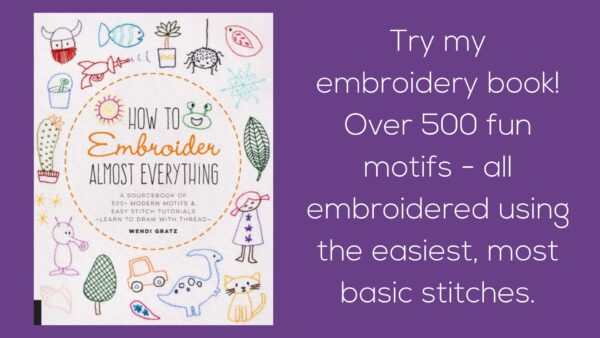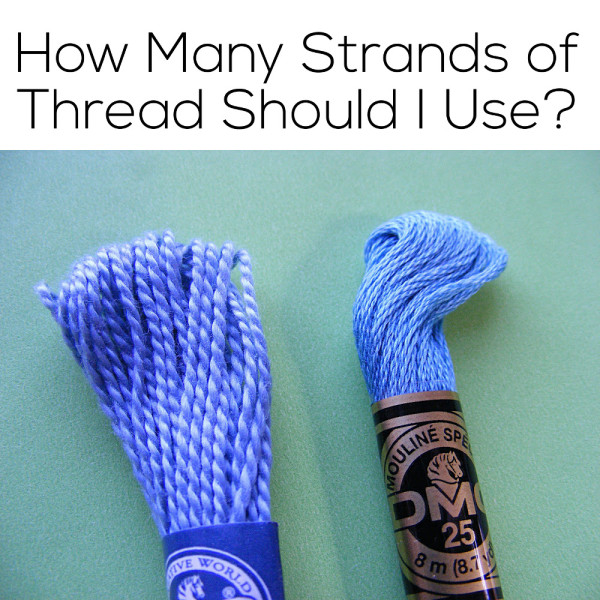I’ve gotten several emails lately from people asking how many strands of embroidery thread they should be using – and how to separate the strands.
How Many Strands of Embroidery Thread to Use
First let’s tackle the question of how many strands to use. It all depends on your project! Think of it like choosing a fat marker or a thin marker. If you’re drawing something pretty small, with lots of fine details, you’re going to use a thin marker/fewer strands of thread.
If you’re drawing something big and bold without a lot of fussy details, you’d choose a fat marker/more strands of thread.
But how do you know how many strands? Well – that involves a bit of trial and error, and a willingness to pick out your stitches if needed. Take your best guess. Stitch an inch or two and then take a look. If I think it needs to be fatter, I’ll unpick, add an extra strand, and try again. If I think it needs to be thinner I’ll unpick, take away a strand, and try again.
Note: I tell you how many strands to use in the color and stitch guide of all my embroidery patterns. 🙂
Of course – save all the strands you separated out! You can still use them.
How Do You Separate Out Just a Few Strands of Floss?
Now – about separating those strands. First make sure you’re using the right kind of embroidery thread. Click on the picture at the top of the post. I loaded up a large file so it should fill the whole screen when you click and let you look very closely.
The thread on the right is called embroidery floss (or thread) – or sometimes stranded cotton. It’s what I usually use. It’s 6 strands of thread that you can separate into as many as you need.
The thread on the left is called perle cotton, pearl cotton, or sometimes craft thread. See how it’s twisted together? You can’t undo that – not without making an unholy mess. It’s lovely to stitch with – and you can buy it in several different thicknesses – but you can’t alter the thickness yourself. My favorite is Sulky 12 wt Petites – the equivalent thickness of 2 strands of regular DMC embroidery floss.
The tricky thing is that these two kinds of thread are often displayed together in the same section of the store. Luckily, it’s easy enough to tell the difference if you know what you’re looking for.
So – now that you have the right kind of thread – how do you separate it without ending up with a snarl?
Don’t cut your thread too long. The experts say it should be no longer than the distance from the tips of your fingers to your elbow – but I confess to cutting mine a bit longer than that.
Now – hold it up in the air so that the whole length of thread is freely dangling down. Tease out the number of strands you want and slowly pull them away from the mother strand. The strands are very lightly twisted together so there will be a bit of untwisting as you pull, but if you pull slowly it shouldn’t tangle.
Stitch away!

Here are all my posts about knots.
- How to Tie a Knot
- How to Tie Off Thread on the Back of Your Embroidery
- How to Embroider with No Knots
Before you knot that thread you need to know how much to use, so here’s one more post that doesn’t really have a better place to live. 🙂 How Many Strands of Thread Should I Use?
Return to the Learn to Embroider main Table of Contents.
Move on to the lessons for the four most basic embroidery stitches.








Great post! I just started experimenting with different numbers of threads, and I’m pleased with the results.
Great post!
I took couple classes here & thank goodness they showed us how to separate it.Take time if you rush gonna knot up on ya,,Thank’s
You can also slide the not wanted strands down the strands you DO want…then go to the end and pulll them on out. Keep doing that until all is out. But the pull apart way is far simpler.
Thank you for answering a question that I was wondering about but hadn’t asked yet! 🙂
hey wendi -“how you doin”?
wendi ,i need you to create a mens underwear!
i have bought patterns from kwik sew and another from sewinglingerie.com and i cant make any sense out of the patterns. i need help!! and im not alone-there are a lot of women who would love to make underwear and shorts for their men as well-and men would love to try their hand at it too-
things like
tiddy whitey,
boxers,
boxer briefs,
mens bathing suits,
and G string’s
and biker shorts
sweat pants
and sweat shorts.
we need patterns that make sense but also good videos that make sense as well.
im just dying to make a decent type of underwear
thanx for the great videos.
(warlocke_rising@yahoo.com)
Hi! Found your post via Pinterest and wanted to share the way I was taught to separate strands is to hold the thread vertically from the top and tease apart one strand at a time. Then using firm (but not too tight) pressure with the hand holding the entire thread, gently pull the single strand out with the opposite hand by pulling straight up. The entire thread will somewhat “ball up” on the floor-side of your hand but you just smooth it back down from the top. Super simple and no reason to deal with twisted strands. 🙂
Hello! I’m not an embroiderer, but a quilter, but have started recently using embroidery to quilt together my layers. I enjoy the technique, but I am completely self taught. So my question is this: for the work that I am doing, 4 strands is what looks best, but I have come across one tiny problem. If I remove 2 strands, the 4 remaining strands embroider very well, but when I combine the other remaining 2 and combine them with another 2 leftover strands, when I embroider, 1 or 2 of the strands always seem to hang just a bit longer on a stitch, leaving a seemingly loose stitch, so I have to pull each strand on every stitch, even if I try readjusting the strands by pulling and smoothing them regularly. Any suggestion on how to correct this?
Hi Annie! I’ve got two thoughts for you. One is to use perle cotton instead of stranded thread. It comes in different sizes and is permanently twisted together so there’s no separating strands. I know that size 12 is the same thickness as 2 strands of DMC thread, so I’m guessing if you want the thickness of four strands you’d look for size 6. If you really want to use stranded thread, have you tried Thread Heaven? It’s a thread conditioner that works really well to keep thread from tangling and has an overall smoothing effect. I started using it when I was satin stitching a large section of a piece and needed the strands to lie perfectly flat and smooth and it worked really well. Hope this helps!
I’m both a quilter x embroidery gal. I have tried pearl cotton but it is too slippery to use. I also have usedpc to tie a quilt but when I tie the knots it comes apart from being too slippery so I never use it .
Try twisting the strands a bit (but not too much) you’ve combined together….wet a finger and run the length of the strands. It kinda melds them into one.
You should be pulling each strand individually. If you need 2 strands, pull 1 and 1 and then put them back together to thread your needle. If you need three pull out 3 individually, etc. You get better coverage and better consistency in your stitching.
I Love your website. I can always find an answer to my questions no matter what it is either sewing , embroidery, quilting or stuffing. I am very happy you are here for me and all the other doers out there. Thank you again and I learned a lot just now on embroidery thread. I was given 2 very large bags of every color you can think of except white or black go figure.
Loved your site.
Thanks for info on
Emb. Threads.
Now on to
Your shop.
Pingback: Wie viele Stickgarnstränge soll ich verwenden? – Dıy – Einfache Bastelideen
How do you store the threads you’ve cut but did not use? Do you put them on a second bobbin, or can you use the lower part of the bobbin to wrap-around?
I store my thread in baggies, so I just pop the extra strands back in the same bag with the rest of my skein. There are more details about my thread storage here. https://www.shinyhappyworld.com/2015/01/store-organize-embroidery-thread.html
Pingback: ¿Cuántas hebras de hilo de bordar debo usar? - Colybrind
Pingback: Embroidery Tools - Shiny Happy World